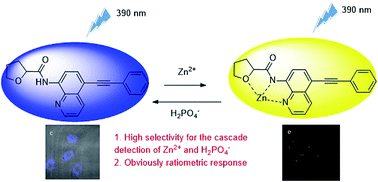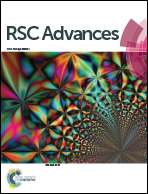A highly selective ratiometric fluorescent probe for the cascade detection of Zn2+ and H2PO4− and its application in living cell imaging†
Abstract
A simple ratiometric sensor (L1) for the cascade detection of Zn2+ and H2PO4− with high selectivity was reported based on the intermolecular charge transfer (ICT) mechanism. This new sensor could distinguish Zn2+ from Cd2+, and features high fluorescence quantum yield with L1 (0.45) and L1–Zn2+ (0.27). There is a good linear relationship between the fluorescence ratio I525 nm/I430 nm upon addition of Zn2+ and the limit of detection (LOD) was evaluated to be 41.0 nM. Furthermore, the in situ prepared L1–Zn2+ complex also displayed good selectivity and ratiometric response for H2PO4− and the detection limit of L1–Zn2+ was found to be 49.0 nM. L1 exhibits permeability and can been applied to the detection of intracellular Zn2+ and H2PO4− in HepG-2 cells.



 Please wait while we load your content...
Please wait while we load your content...